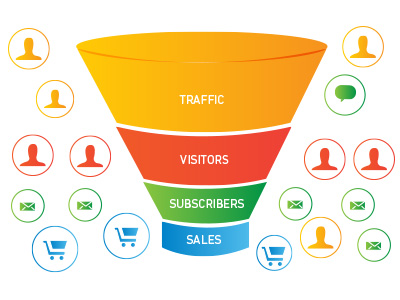 An effective Sales funnel is the key to increase the performance of our website, whether it’s an e-commerce or not. There are several factors to consider when Building an Effective Sales Funnel. It has to be designed in a certain way to make it work. Over time, we’ll have to go by measuring, adjusting and optimizing to improve its performance.
An effective Sales funnel is the key to increase the performance of our website, whether it’s an e-commerce or not. There are several factors to consider when Building an Effective Sales Funnel. It has to be designed in a certain way to make it work. Over time, we’ll have to go by measuring, adjusting and optimizing to improve its performance.
A series of steps must be taken into account when designing the effective sales funnel. First of all, we want to make the user visit our website. To do so, the brand or product needs to be noted, made public and thus drive traffic to the site. At this stage, we must consider which is the best way to achieve it. We can use the Google Adwords tool, which allows us to find out what words our potential buyers use to search our product or service. These are the “keywords” that we must consider and that provide websites a good positioning in search engines and other sites. Some of the techniques used in marketing online to attract traffic are: SEO, online advertising campaigns (sponsored links, display campaigns, banners and affiliate sites), Email marketing campaigns, content marketing using blogs and social media among other things.
Our second step is to make these visitors into subscribers, buyers or to any action we are looking to achieve through the site. We must ensure that users who enter our website perform this “conversion”. i.e. getting subscribers to our newsletter database or completing a contact form or directly buying our product or service.
Through these actions we can create a relationship with the user, measuring which are the incentives that are receiving greater response and taking into account what information you can provide the user in order to perform a conversion. Some elements to consider at this stage are: the design of the website (a clear and relevant website will be more attractive), navigation: we must ensure that our site is easy to navigate and loading times are short enough so that users do not leave the page before it is fully loaded) Something that is frequently used is the “Wish List”, i.e. lists where the user selects the products they want to buy and are registered until the next time they access the page. Using specific landing pages for certain promotional activities with relevant information and calls to action, are very helpful and are key in the conversion process.
To continue, we must persuade the user. Once we create a bond with him, we should aim to increase these conversions and generate one or more purchases. We must ask ourselves what we should do in order to make the purchase happen. An effective way to get these answers is surveying our customers or page visitors. You can offer a chat as a support to answer any queries immediately. Moreover, you can use digital newsletters or entries on social networks. In addition, through re-marketing campaigns you can reach those who ever entered your page and launch some specific promotional campaign to get them.
The next step will be to close the deal. Surprising the user is one of the ways of achieving the purchase. There are varied ways we can do this, such as offering some benefit and product promotions. Another way may be customizing the product, making it more personal and involving the user.
Ultimately, we aim to transform our customers into fans of our products and brand. Get them to evangelize about our brand is our biggest challenge. Word of mouth is one of the oldest and most efficient tactics in the world. Therefore, if we make our customers speak about our products or services in social networks or with their friends, our brand will grow faster. This will contribute to more visits to our website and to improve conversions.


